Butcher block countertops, known for their warmth and natural beauty, are a fantastic addition to any kitchen, and caring for butcher block countertops is easier than you might think. CARS.EDU.VN provides this comprehensive guide, outlining essential cleaning techniques, oiling methods, and maintenance tips to keep your wooden surfaces pristine for years to come. Learn expert wood surface protection and butcher block stain removal tips right here.
1. Understanding Butcher Block Countertops
Butcher block countertops are a popular choice for kitchens due to their durability, functionality, and aesthetic appeal. They are typically made from hardwoods like maple, walnut, or cherry, and constructed by joining multiple pieces of wood together to create a solid surface. Their natural antibacterial properties and warm aesthetic make them a favorite for both food preparation and a stylish kitchen design.
1.1. Types of Butcher Block
Understanding the different types of butcher block is crucial for proper care. Here’s a quick overview:
- End Grain: This is considered the most durable type. It features the ends of the wood fibers, making it ideal for heavy chopping and cutting. End grain blocks tend to be more expensive due to their construction.
- Edge Grain: Made by gluing long, narrow strips of wood together on their edges, this type is more affordable and offers a smooth, uniform look.
- Face Grain (or Wide Plank): This shows the flat surface of the wood, providing a decorative appearance. However, it’s the least durable option and more susceptible to scratches and knife marks.
1.2. Benefits of Butcher Block
Butcher block countertops offer numerous advantages:
- Durability: When properly maintained, butcher block can last for decades.
- Aesthetic Appeal: The natural wood grain adds warmth and character to any kitchen.
- Food Safety: Wood has natural antibacterial properties, making it a hygienic surface for food preparation.
- Versatility: Suitable for various kitchen tasks, from chopping vegetables to rolling out dough.
- Repairability: Scratches and minor damages can often be sanded out and re-oiled.
1.3. Addressing Common Concerns
Many people hesitate to choose butcher block due to concerns about maintenance and hygiene. However, with the right care routine, these concerns can be easily managed. Regular cleaning, oiling, and prompt attention to spills can keep your butcher block countertops in excellent condition.
2. Essential Tools and Materials for Butcher Block Care
Having the right tools and materials on hand will make maintaining your butcher block countertops much easier. Here’s a comprehensive list:
| Tool/Material | Description |
|---|---|
| Food-Grade Mineral Oil | Essential for conditioning the wood, preventing it from drying out and cracking. It’s non-toxic and safe for food contact. |
| Board Butter | A mixture of mineral oil and beeswax, providing extra protection and a smooth finish. You can buy it pre-made or make your own. |
| White Vinegar | A natural disinfectant that can be used to clean and sanitize the surface. |
| Mild Dish Soap | Use a small amount of mild dish soap for general cleaning. Avoid harsh detergents that can strip the wood of its natural oils. |
| Soft Cloths | Lint-free cloths are ideal for applying oil and wiping down the surface. |
| Dough Scraper | Useful for removing stuck-on food particles without scratching the wood. |
| Razor Blade Scraper | For carefully removing light surface stains. |
| Sandpaper (Various Grits) | For removing deeper stains and scratches. Start with a coarser grit (120-180) and finish with a finer grit (220-320) for a smooth surface. |
| Orbital Palm Sander | Optional, but helpful for sanding larger areas more efficiently. |
| Magic Eraser | For removing surface stains quickly and easily. |
| Cleaning Brush | Ideal for scrubbing stubborn stains or debris. Look for brushes with soft bristles to avoid damaging the wood. |
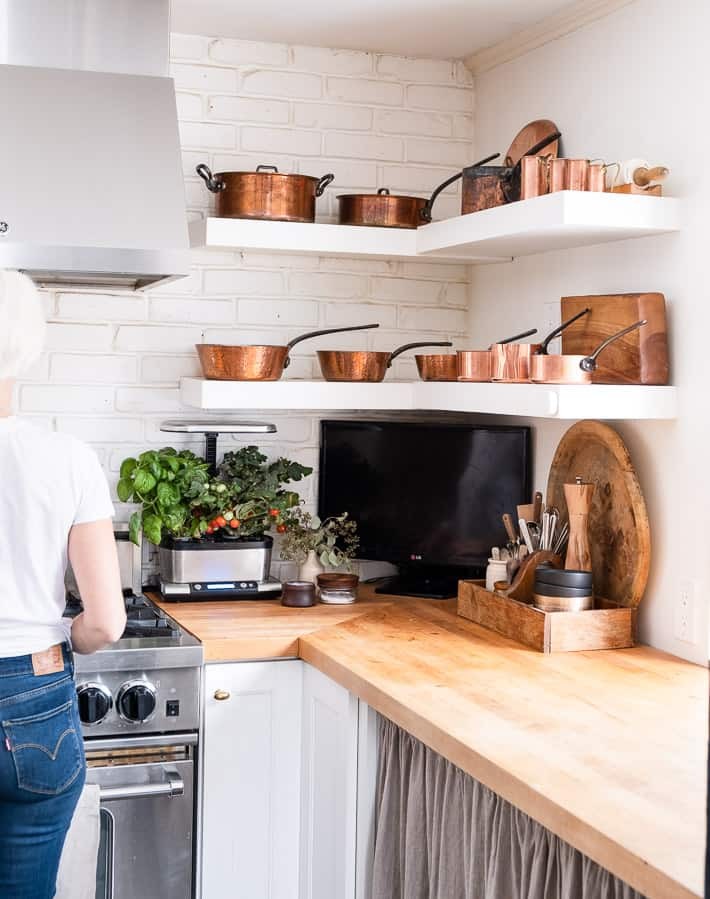
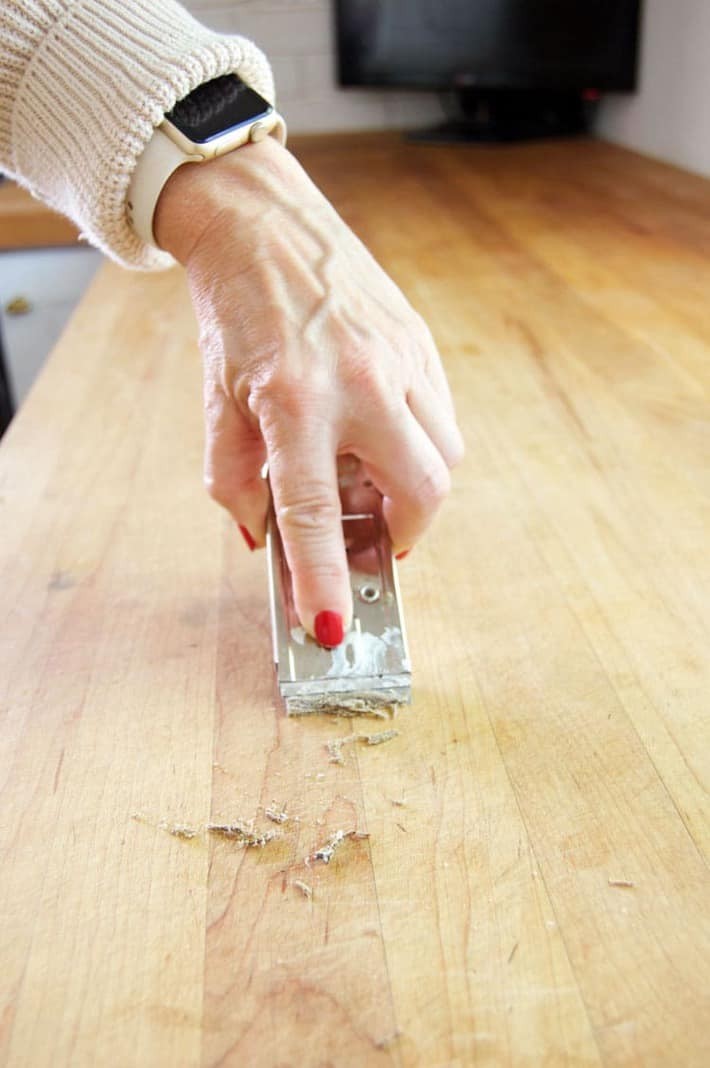
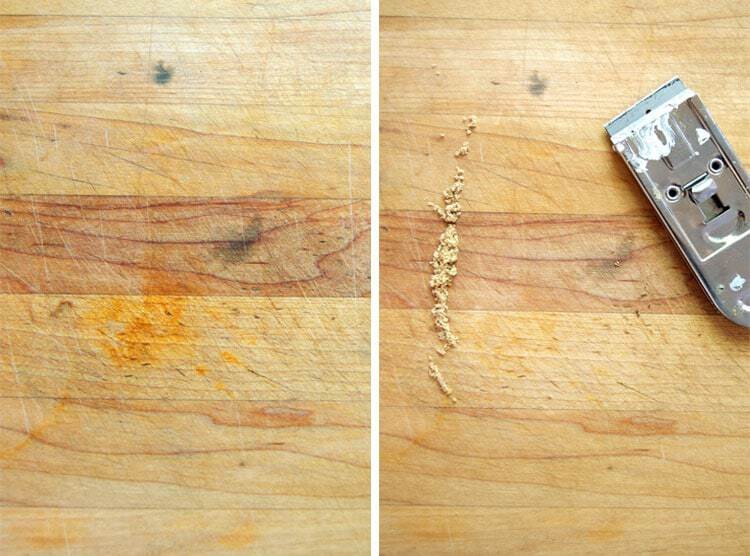
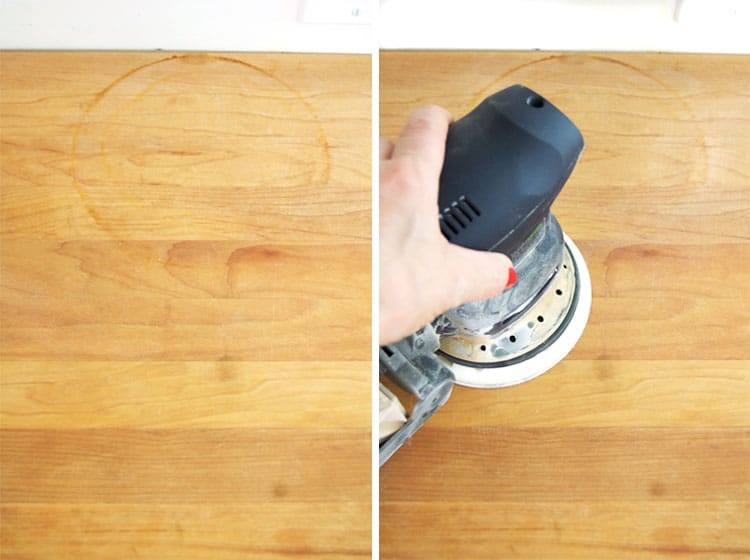
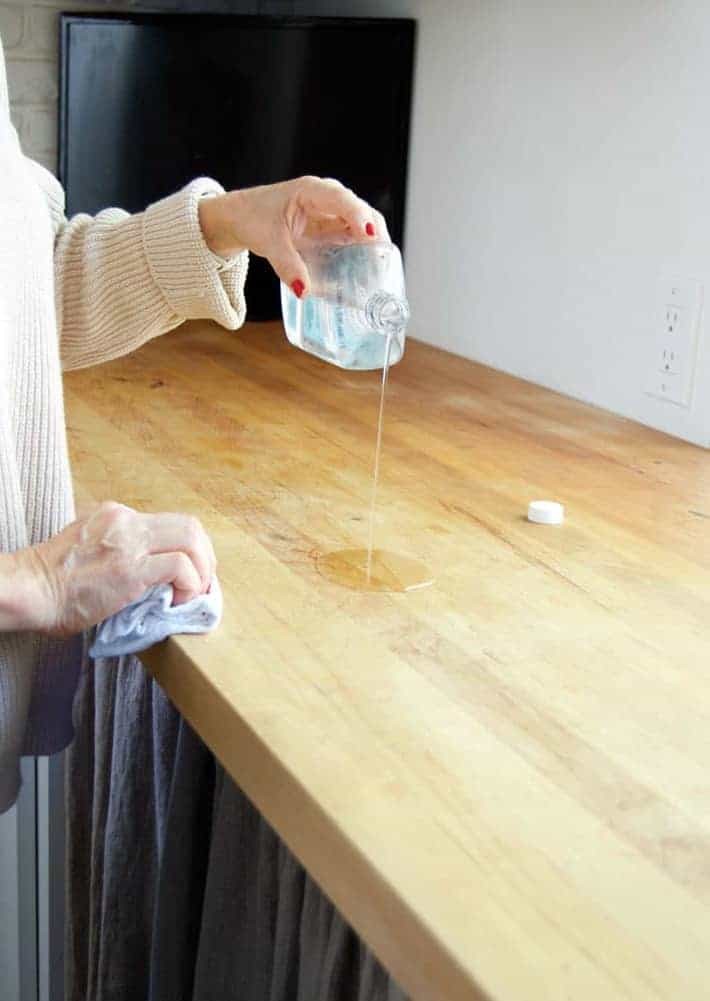


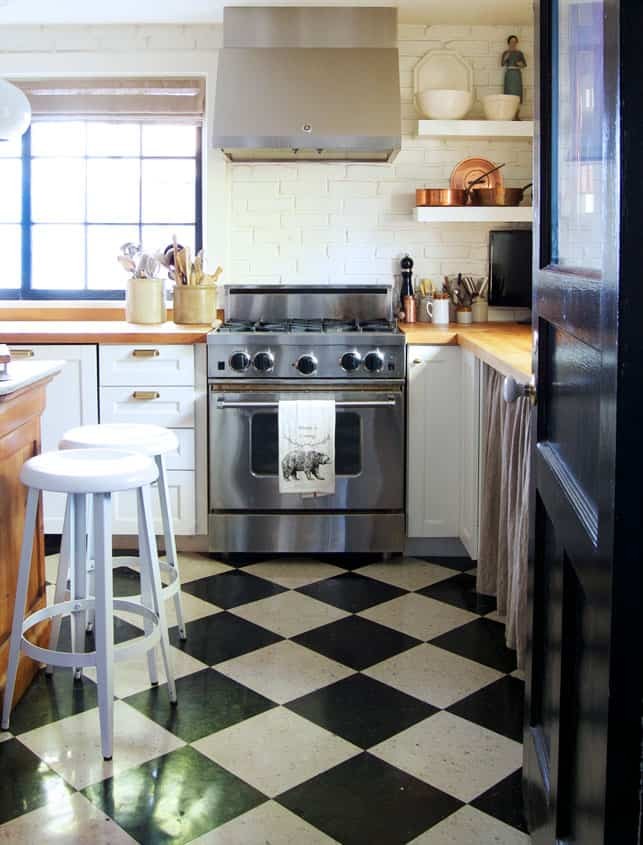
3. Daily Cleaning Routine
A consistent daily cleaning routine is crucial for maintaining the beauty and hygiene of your butcher block countertops.
3.1. Immediate Spill Cleanup
One of the most important rules for maintaining butcher block countertops is to clean up spills immediately. Liquids like water, juice, wine, and coffee can penetrate the wood and cause stains or even warping if left unattended. Use a clean, dry cloth to wipe up any spills as soon as they occur.
3.2. Gentle Washing
After each use, wash the countertops with a soft cloth dampened with warm water and a small amount of mild dish soap. Avoid using excessive water, as this can seep into the wood and cause damage. Gently wipe the surface to remove food residue and grime.
3.3. Disinfecting
To disinfect your butcher block countertops, use a solution of equal parts white vinegar and water. Apply the solution with a clean cloth and let it sit for a few minutes before wiping it off. Vinegar is a natural disinfectant that effectively kills bacteria without harsh chemicals.
3.4. Drying Thoroughly
After washing and disinfecting, it’s essential to dry the countertops thoroughly. Use a clean, dry cloth to remove any remaining moisture. This will prevent water from soaking into the wood and causing warping or discoloration.
4. Deep Cleaning and Stain Removal
Even with a diligent daily cleaning routine, your butcher block countertops may occasionally require a deeper cleaning to remove stains and buildup.
4.1. Removing Stuck-On Food
For stubborn food particles, use a dough scraper to gently remove them from the surface. Hold the scraper at a slight angle and carefully scrape away the debris. Avoid applying too much pressure, as this can scratch the wood.
4.2. Addressing Light Stains
For light surface stains, a razor blade scraper can be effective. Gently scrape the surface of the wood to remove the stain. Be careful not to apply too much pressure, as this can damage the wood.
4.3. Sanding Deeper Stains
Deeper stains may require sanding. Start with a coarser grit sandpaper (120-180) to remove the stain, then follow up with a finer grit (220-320) to smooth the surface. Sand in the direction of the wood grain and be careful not to sand too aggressively.
4.4. The Magic Eraser Trick
For quick removal of surface stains, try using a magic eraser. Dampen the eraser and gently rub it over the stain. This can be particularly effective for removing food stains without lightening the color of the wood.
4.5. Baking Soda Paste
Create a paste of baking soda and water to tackle tough stains. Apply the paste to the stained area, let it sit for a few minutes, and then gently scrub with a soft cloth or brush. Rinse with water and dry thoroughly.
5. Oiling Butcher Block Countertops
Oiling is a crucial step in maintaining butcher block countertops. It helps to protect the wood from moisture, prevent cracking, and enhance its natural beauty.
5.1. Why Oiling is Important
Oiling creates a protective barrier that prevents moisture from seeping into the wood and also stops moisture from escaping. According to Jason Stafford of Talbot Wood, proper oiling is essential for maintaining the integrity and longevity of butcher block countertops.
5.2. Choosing the Right Oil
Food-grade mineral oil is the most commonly recommended oil for butcher block countertops. It’s non-toxic, odorless, and tasteless, making it safe for food preparation surfaces. You can find it at most drugstores or hardware stores. Board butter, a mixture of mineral oil and beeswax, is another excellent option.
5.3. How to Oil Butcher Block
Follow these steps to properly oil your butcher block countertops:
-
Prepare the Surface: Ensure the countertops are clean and dry. Remove any debris or stains using the methods described above.
-
Apply the Oil: Pour a generous amount of mineral oil directly onto the counter.
-
Spread the Oil: Use a lint-free cloth to spread the oil evenly over the entire surface.
-
Allow Absorption: Let the oil soak into the wood for at least an hour, or preferably overnight.
-
Wipe Off Excess: Use a clean cloth to wipe off any excess oil. The surface should feel smooth and slightly oily, but not greasy.
5.4. How Often to Oil
The frequency of oiling depends on several factors, including the age of the countertop, the climate, and how often it’s used. As a general rule, oil your butcher block countertops every month or two. In drier climates or during the winter months, you may need to oil them more frequently. If the oil soaks in quickly, it’s a sign that the wood is dry and needs more oil.
5.5. Alternative Oils
If you prefer not to use mineral oil, there are alternative options:
- Refined Coconut Oil: Unlike regular coconut oil, refined coconut oil has been distilled to remove the odor and flavor and is less likely to go rancid.
- Tung Oil: This oil can bring out a golden color in the wood and should be avoided if anyone in your household has nut allergies.
6. Preventing Damage and Maintaining Longevity
Taking preventative measures can significantly extend the life of your butcher block countertops.
6.1. Avoid Excessive Moisture
While butcher block is durable, excessive moisture can cause warping, cracking, and discoloration. Always wipe up spills promptly and avoid leaving wet cloths or sponges on the surface.
6.2. Use Cutting Boards
To protect the surface from scratches and knife marks, always use cutting boards when preparing food. This will also help to maintain the smooth, even surface of your countertops.
6.3. Protect from Heat
Avoid placing hot pots, pans, or appliances directly on the butcher block surface. Use trivets or heat-resistant mats to protect the wood from heat damage.
6.4. Avoid Harsh Chemicals
Harsh cleaning chemicals, such as bleach or ammonia, can strip the wood of its natural oils and damage the surface. Stick to mild dish soap, white vinegar, and other gentle cleaning solutions.
6.5. Regular Maintenance
Regular maintenance, including cleaning, oiling, and addressing minor issues promptly, will keep your butcher block countertops in excellent condition for years to come.
7. Reviving Old or Neglected Butcher Block
If you’ve inherited old or neglected butcher block countertops, don’t worry – they can often be revived with some effort and the right techniques.
7.1. Thorough Cleaning
Start by thoroughly cleaning the countertops to remove any dirt, grime, and old oil buildup. Use a solution of warm water and mild dish soap, and scrub the surface with a soft brush or cloth.
7.2. Sanding
Sanding is often necessary to remove deep stains, scratches, and unevenness. Start with a coarse grit sandpaper (80-100) to remove the damaged surface, then gradually move to finer grits (120-180, then 220-320) to smooth the surface. Use an orbital sander for larger areas, and always sand in the direction of the wood grain.
7.3. Addressing Cracks and Gaps
If there are cracks or gaps in the butcher block, fill them with wood filler. Apply the filler according to the manufacturer’s instructions, let it dry, and then sand it smooth.
7.4. Oiling and Sealing
After cleaning and sanding, apply several coats of food-grade mineral oil to rehydrate and protect the wood. Allow each coat to soak in for several hours before wiping off the excess. For added protection, consider applying a coat of board butter after the oil.
7.5. Ongoing Maintenance
Once you’ve revived your butcher block countertops, establish a regular cleaning and oiling routine to keep them in excellent condition.
8. Butcher Block Countertops in Modern Kitchen Design
Butcher block countertops are a versatile design element that can complement a wide range of kitchen styles.
8.1. Pairing with Different Cabinet Colors
Butcher block pairs beautifully with both light and dark cabinet colors. For a bright and airy look, combine butcher block with white or light-colored cabinets. For a more dramatic effect, use butcher block with dark wood or painted cabinets.
8.2. Complementing Backsplash Designs
Choose a backsplash that complements the warm tones of the butcher block. Subway tiles, natural stone, and glass mosaics are all excellent options.
8.3. Integrating with Kitchen Islands
A butcher block countertop can be a stunning addition to a kitchen island. Use it as a focal point for food preparation or as a stylish serving area.
8.4. Creating a Warm and Inviting Space
Butcher block countertops add warmth and character to any kitchen, creating a welcoming and inviting space for cooking and gathering.
9. Common Mistakes to Avoid
Avoiding these common mistakes will help you keep your butcher block countertops in top condition:
- Using Harsh Cleaners: Harsh chemicals can damage the wood and strip it of its natural oils.
- Ignoring Spills: Allowing spills to sit on the surface can lead to stains and warping.
- Skipping Oiling: Neglecting to oil the countertops can cause the wood to dry out and crack.
- Using Abrasive Scrubbers: Abrasive scrubbers can scratch the surface of the wood.
- Exposing to Excessive Heat: Placing hot items directly on the countertops can cause heat damage.
10. Frequently Asked Questions (FAQ)
Q1: How often should I oil my butcher block countertops?
A: Generally, oiling every month or two is a good rule. However, factors like climate and usage frequency can affect this.
Q2: Can I sand my entire countertop to remove all stains?
A: Yes, you can sand the entire countertop to remove surface stains. Start with coarse sandpaper and gradually move to finer grits.
Q3: What type of oil can I use if I don’t want to use mineral oil?
A: Refined coconut oil and tung oil are alternatives, but tung oil should be avoided if there are nut allergies.
Q4: Do I need to oil the countertops more than once initially?
A: Yes, especially if the countertops are very dry. Apply several coats until the wood stops absorbing the oil quickly.
Q5: How do I remove water stains from my butcher block countertops?
A: Sand the stained area with 180-grit sandpaper, then 220-grit sandpaper. Re-oil the area to protect it.
Q6: Can I use bleach to clean my butcher block countertops?
A: No, bleach is too harsh and can damage the wood. Stick to mild soap and water or a vinegar solution.
Q7: How do I prevent my butcher block countertops from warping?
A: Avoid excessive moisture and always dry the surface thoroughly after cleaning. Regular oiling also helps prevent warping.
Q8: Is it safe to cut directly on my butcher block countertops?
A: While butcher block is durable, using cutting boards will help prevent scratches and maintain the smooth surface.
Q9: How do I make my own board butter?
A: Combine mineral oil and beeswax in a 4:1 ratio. Melt the beeswax, then mix in the mineral oil and let it cool.
Q10: Can I use butcher block countertops outdoors?
A: Butcher block is not recommended for outdoor use as it is susceptible to weather damage.
Butcher block countertops can transform your kitchen with their natural beauty and functionality. By following these tips from CARS.EDU.VN, you can ensure that your butcher block countertops remain in excellent condition for years to come. Regular cleaning, proper oiling, and preventative measures are key to maintaining their beauty and durability.
Are you looking for more in-depth information about maintaining your car’s interior, including wood trim and other surfaces? CARS.EDU.VN offers a wealth of knowledge and resources to help you keep every aspect of your vehicle in top shape. Visit CARS.EDU.VN today to explore our articles and service guides.
For expert advice and services, contact us at:
Address: 456 Auto Drive, Anytown, CA 90210, United States
WhatsApp: +1 555-123-4567
Website: cars.edu.vn
